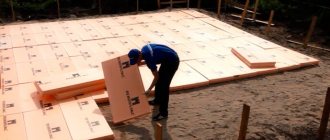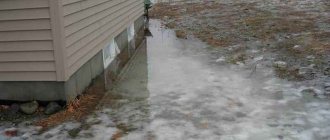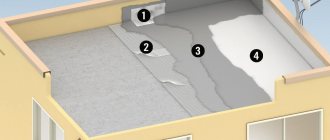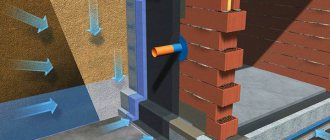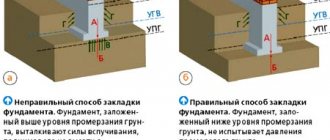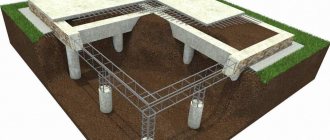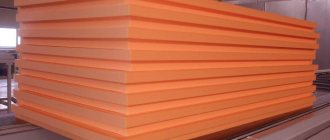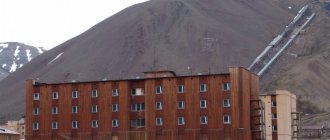Water is the main enemy of the foundation, destroying concrete and reducing the design strength of the foundation.
The main protection against the effects of groundwater and penetrating precipitation is the application of waterproofing to the surface of the foundation and under its support pad. Depending on the materials adopted, different technologies for waterproofing the foundation are used at the stages of construction of a residential building. Simple waterproofing is easy to do with your own hands, but it is necessary to provide for its type at the design stage. Here the main criteria are: what type of waterproofing is needed in the specific hydrogeological conditions of the load-bearing soil layer, economic justification, the possibility of using the technology, and the availability of materials. This is important to know for the correct formation of foundation protection.
Types and types of waterproofing
Foundation waterproofing is based on three main types:
- horizontal,
- vertical,
- drainage.
Gone are the days when the only type of waterproofing was to apply a layer of bitumen to the side walls of the foundation. In Russia, with the development of technology parks, clusters with modern laboratories and accessible equipment are being formed where projects are being developed in the direction of obtaining innovative technologies and materials for protecting surfaces from the effects of water.
Horizontal and vertical waterproofing
Here are some modern types of waterproofing used to protect and strengthen foundations:
- coating,
- pasting,
- welded,
- penetrating,
- injection with microcements,
- polymer cement,
- liquid,
- elastic,
- membrane,
- cut-off,
- seamless rubber,
- application of polyurea,
- shotcrete,
- drainage,
- water reduction
The main thing here is to choose the right type of waterproofing necessary to protect the foundation. The work is carried out in accordance with the provisions of SP 71.13330.2012.
It is important to understand that not all types of protection can be performed independently. There are those when special equipment and materials are required. This significantly affects material costs, time of work on E&R and in reality. To the question of whether it is necessary to do waterproofing, there is only one answer - it is necessary, even if at the given period the soils are not wet and the groundwater level is deep.
Waterproofing work is carried out only on a cleaned, leveled, dry surface (SP 45.13330 clause 15.3). Permissible humidity is standardized according to SP 71.13330.2012.
Before use, carefully read the manufacturer’s recommendations for the use of the material: permissible temperature of the material during application or gluing, maturation period for multi-component material, time during which it is necessary to apply the material to the concrete surface. Following the manufacturer's instructions will ensure long-term surface protection.
The applied waterproofing must be protected by a protective film, synthetic coating, and polymers (SP 45.13330 clause 15.7). Carefully monitor the integrity of the insulation and carefully fill the sinuses. In seismic areas, insulate communication pipeline entries using elastic materials (SP 45.13330 clause 15.21).
Stages of work
In order for the waterproofing to adhere well to the base, the surface must be prepared. These operations do not take much time, but guarantee a high-quality result.
- Preparatory procedures include removing dust and dirt from the coating. If there are scratches or cracks on the surface, they must be covered. If the base is made of concrete and there are joints on it, they must first be compacted. Waterproofing tape is suitable for this.
Tape for gluing joints
Sealing tape is glued at the junction of walls and ceiling. In the bathroom, the communication outlets are taped.
- Do not neglect the primer; for concrete and brick bases, use a deep penetration primer. Such compositions improve the adhesion of the waterproofing layer, and some primers may also have antiseptic properties - they prevent the appearance of fungus and mold.
If bitumen waterproofing is used, then before applying a layer of mastic the room should be dried; for this you can use a heat gun or an infrared heater.
- To apply liquid mastic, a brush or roller with a long handle is suitable. Depending on the consistency of the material, you can use a spatula. When treating the floor in a room with high humidity, the overlap on the walls should be at least 20 mm. Waterproofing does not dry instantly, so during polymerization it is necessary to isolate the room from dust and debris.
Waterproofing the bathroom floor
- When the mastic dries, you can begin further work.
Coating waterproofing
Coating vertical insulation is one of the oldest, but still quite popular today methods of protecting reinforced concrete structures from moisture. Modern innovative materials for the formation of protective coatings allow:
- apply insulation to any previously prepared surface, regardless of configuration;
- carry out the process of applying the material with a roller, brush, or spatula without the use of special mechanisms;
- form a monolithic protective layer on the surface;
- close pores, microscopic shrinkage cracks, securely attach the protective layer to the surface being treated.
Materials for coating insulation are supplied in ready-to-use form or as a multi-component kit. Please read the instructions carefully before use. Some popular materials for vertical coating insulation and their characteristics are shown in the table below.
| Material | Type of delivery | Description | Price |
| Insulating mastic 10 liters | Waterproofing mastic based on petroleum bitumen with technological and mineral additives. Average consumption - 1 kg/m^2. Ready to use. | 389 | |
| Bitumen-rubber mastic 10 liters | Mastic based on modified bitumen, plasticizer with antiseptic additives, corrosion inhibitor. Ready to use. Consumption 1 kg/m^2. Read the instructions for safe use carefully. | 284 | |
| Waterproofing mastic Bitumast 5 liters | Coating mastic used for mildly and moderately aggressive soils. Consumption 0.5 kg/m^2. Does not contain toxic solvents, flammable. | 390 | |
| Hiperdesmo-Classic mastic 1 kg | Polyurethane one-component mastic. Designed for repairing bitumen insulation. Average consumption - 1.3 kg/m^2. | 699 |
Polymer cement foundation protection
The material, according to the application method, refers to coating insulation. Supplied in bags as a dry mixture or an aqueous solution.
The main components are cement, sand, polymer, additives that accelerate the dehydration process and improve the properties of the material. It is necessary to strictly follow the recipe for preparing the mixture.
When applied to the surface, the polymer-cement mixture penetrates the pores, cracks, and structure of concrete, enhances its hydrophobic characteristics, and creates an impenetrable barrier against groundwater. The mixture is applied with a brush, roller, or trowel in one or several passes.
After drying, a membrane is formed, firmly connected to the surface of the concrete, impermeable to water. The disadvantages of the method include:
- Formation of microcracks during the rapid formation of a protective layer or deformation of the base.
- Strict adherence to the proportions and quality of water when preparing the polymer-cement mixture.
Video description
The whole process and possible nuances are clearly shown in the video:
The minimum number of layers is 2. Each next one is applied after the previous one has dried.
After completing the creation of the waterproofing layer, the floor is ready for pouring the screed and laying the finishing coating (tiles or self-leveling polymer floors).
Self-leveling 3D floors can be misleading Source pol-master.com
Elastic waterproofing
Such rubber insulation is called elastic.
Elastic insulation refers to the application of a coating of liquid rubber - bitumen-latex emulsion by spraying. The material is supplied one-component or two-component.
The process of applying the emulsion requires the use of special technology and equipment. When using a two-component material, you must have a sprayer with two nozzles. According to the technology, mixing of components occurs at the moment the material hits the surface to be treated.
Requirements when applying the emulsion:
- Clean the surface from dust, oil stains, and prime.
- The emulsion is sprayed onto a dry surface at a temperature > +5 degrees.
- The formation of the membrane occurs within 2 hours; moisture ingress during this period is not allowed.
- Spraying on vertical surfaces is done from bottom to top without joints.
- When carrying out work, comply with safety requirements, wear protective clothing and glasses.
Foundation protection with polyurea
Polyurea is a multicomponent organic polymer. Components: isocyanate, polyester amine resin.
To apply polyurea, you will need special equipment that provides heating before spraying the components to a temperature of >+80 degrees, separate supply to the mixing chamber of the gun and to the treatment site under a pressure of >1.7 atm.
Polyurea is applied for horizontal and vertical waterproofing.
After connecting the components and contacting the surface to be treated, the mixture hardens within 10 seconds. A durable layer is formed, similar to hard rubber or plastic.
Characteristics of the resulting polyurea layer:
- thickness: 0.5—2.5 mm;
- Full readiness for use 1 minute after application;
- no seams;
- operating mode from -60 to +250 degrees;
- strength up to 80 Shore D;
- corrosion and abrasion resistant coating;
- service life >30 years.
Plastering
It is a type of coating-type waterproofing and is used to level surfaces. The material is a dry mixture to which components are added for water resistance. It must be applied with a spatula or brush.
Foundation for a garage - description of construction technology and selection of the optimal typeWhich foundation is better - how to make the right choice depending on the type of soil
Building a foundation - where to start building a foundation and a step-by-step description of the construction technology with your own hands
Penetrating waterproofing
The coating type includes an innovative technology for protecting concrete from capillary filtration of water - penetrating insulation (penetrating). Unlike mastics, solutions of penetrating insulation work in the concrete body itself, contacting and spreading through capillary channels, microcracks up to 0.3 mm towards water under the influence of osmotic pressure.
Upon contact with water, chemically and biologically resistant crystals are formed that block capillary channels and cracks. In addition to maintaining the water resistance of the concrete body, resistance to acids, alkaline solutions, frost resistance up to P 300 increases, and a mechanically and chemically strong layer is formed on the surface.
The dry mixture includes:
- Portland cement mixture
- specially treated sand,
- complex of chemical additives.
The technology of application is similar to the coating method of application:
- The surface is being prepared. It is cleaned of dust, dirt, and grease to open the capillary channel systems as much as possible. The surface is moistened until completely saturated, primed with a solution of 1 part water and 1 part dry mixture.
- The working solution for application to the surface must be prepared according to the instructions, taking into account the volume that is consumed during 30-45 minutes of continuous work.
- The finished solution is applied with a brush, spatula or shotcrete method for large volumes of work outside and inside the foundation.
| Material | Type of delivery | Description | Price |
| Aquatron 6 5 kg №5 | Used as an additive to concrete mix - 3% by weight of concrete or applied as a solution on both sides of the foundation of buildings with a basement | 1200 | |
| Gidrotex-B - hydroseal 6kg №6 | It is used for sealing and eliminating pressure leaks with constant active infiltration of groundwater in basements. | 1016 | |
| Biytron F-6 №7 | Ensures the tightness of the foundation at a pressure of up to 2 MPa, the strength of the resulting coating >300 MPa, operation from -60 to +200 degrees. | 400 per 1 kg |
What brands of compounds can you buy?
Quite a few types of penetrating waterproofing are now sold on the construction market. Moreover, there are both formulations from well-known manufacturers, and those that have appeared quite recently and are not yet familiar to a wide range of consumers. Experts advise purchasing only proven formulations, which will be discussed below. The most common options are Lakhta, Penetron, Hydrohit, etc. They all differ from each other in price and a number of technical features.
Penetrating waterproofing for concrete LAKHTA
On a note! In the USSR, the cheapest and most famous waterproofing in Russia, GKZh-11N, was used, consisting of the organosilicon salt of sodium methyl siliconate. In its finished form it was an aqueous emulsion. After drying, it not only protects the walls from water, but also increases the frost resistance of concrete up to 400 cycles.
Prices for coating waterproofing
Coating waterproofing
Penetron: everything about it
This name combines several types of waterproofing compounds, using which together, you can achieve excellent quality of work. This is one of the most common options for penetrating waterproofing. The component consumption is about 0.95 kg/m2, provided that it is coated in two layers. If the surface being treated is uneven, the consumption may increase slightly.
Penetrating waterproofing PENETRON
It is easy to work with the Penetron mixture - the preparation instructions are extremely simple. The composition must be prepared immediately before use, like other types of penetrating waterproofing. The preparation method is as follows: the composition must be mixed with water in a ratio of 2:1, and you need to pour the dry composition into the water and mix. Next, you just need to continuously apply the finished composition to the wet surfaces to be treated. After the first coat has been applied, you need to wait a little time for it to set and then apply the second coat. Further work on improving the surface can be carried out 3 days after applying the waterproofing.
The main disadvantage of Penetron is its high cost. However, its characteristics make it possible to fully recoup all costs.
Penecritus and Penebar as an addition to Penetron
The Penecrit composition allows you to process joints and abutments of a number of concrete structures and provide waterproofing in these areas. And Penebar is a gasket made of composite materials, which allows all seams to be sealed to the maximum. If you wet it, it increases in size and fills all the free space.
Penebar
Attention! Both of these materials must be used together with Penetron waterproofing to achieve maximum results.
Penecrit is easy to prepare - it is mixed with water 1:4 until it becomes plasticine. No more than 5-7 kg of mixture is prepared for one application. Before filling the cracks, they must be cleaned with a brush and cleared of dust. The cracks should measure about 25mm wide and about 45mm deep.
Pasted waterproofing
The use of adhesive insulation is a simple and quick method of protecting the foundation of a shallow house, buried with a basement or without a basement.
Material classification:
- based on bitumen with a built-up or self-adhesive backing;
- polymer;
- bitumen-polymer;
- PVC membranes;
- cutting off.
Laying built-up waterproofing
The technology for installing roll materials is simple, accessible for doing the work on your own:
- The surface is prepared, leveled, and dried.
- A layer of pasting mastic and hot bitumen with a temperature of >200 degrees is applied. Layer thickness >5 mm.
- The material is glued and rolled tightly onto the surface with a roller. Pasted waterproofing can be multi-layered, but only with mastic.
- Overlap horizontally >150 mm, at vertical joints >100 mm.
- The joints are additionally coated with polymer glue.
- Coating insulation is applied to the top layer.
Innovative PVC membrane protection is applied in the same way. The application of polymer (membrane) has no restrictions in weather conditions (up to -15 degrees) during installation. The seams are welded with a heat gun or covered with tape.
PVC membranes are of film or profiled type for uniform distribution of soil pressure along the foundation wall and drainage of groundwater. The cost of a PVC membrane varies from $30 to $120 per 50 m.p.
Materials intended for fused insulation have an adhesive bitumen or polyethylene layer. During installation, the roll is laid with the adhesive side to the surface of the tape, heated by a burner over the area, pressed and rolled out with a roller. The joints are treated with hot bitumen or polymer glue. It is recommended to apply 2-3 layers of protection using roll materials.
Trust the experts
As practice shows, errors in waterproofing are difficult and expensive to correct during operation, so for safety reasons you should contact specialists at the construction stage. It is better to do waterproofing when erecting a building, because repairing the foundation in the future will be more expensive and require more labor than erecting a house. Experts will analyze the surface of the building site and recommend the most suitable type of foundation. They will competently and quickly calculate its installation, taking into account ventilation, sewerage and all utility networks. Specialists from construction companies will carry out high-quality construction of the foundation, organization of waterproofing, and insulation of the structure.
Ratings 0
Shotcrete and drainage
Shotcrete is the most effective method of vertical waterproofing of foundation walls and joints. The principle of shotcrete is applying under pressure to the surface to be treated a mixture of well cement with hard coarse-grained sand without impurities or artificial sand.
Shotcrete technology requires the use of specialized equipment, so this work cannot be done correctly on your own. You will have to place an order with a third party.
Shotcrete eliminates all questions regarding waterproofing the foundation. The service life of the object is unlimited.
Linear drainage is used to drain moisture-saturated soils by laying perforated pipes and draining water into special sumps with subsequent pumping.
Linear drainage is installed below the support pad of the foundation base. First, geotextile (dornite) is placed under the base of the pillow in 2 layers with the side ends bent 70-80 centimeters, horizontal waterproofing is done on top of the pillow. Then a perforated pipe is laid down with a slope towards the sump, covered with a sand-gravel mixture as a filter material, and the ends of the geotextile are bent.
Material requirements
A large number of waterproofing materials, differing in properties and characteristics, must comply with construction standards. Coating solutions are basically mastic materials. Their use at low temperatures is not permitted, but very high temperatures are not suitable for working with waterproofing.
Seamless waterproofing surface, laid in several layers, observing technological breaks. The layer thickness declared by the manufacturer may differ, but each composition must meet the standards:
- long service life;
- excellent moisture resistance;
- endurance to mechanical load;
- resistance to chemical components;
- elasticity.
Return to contents
